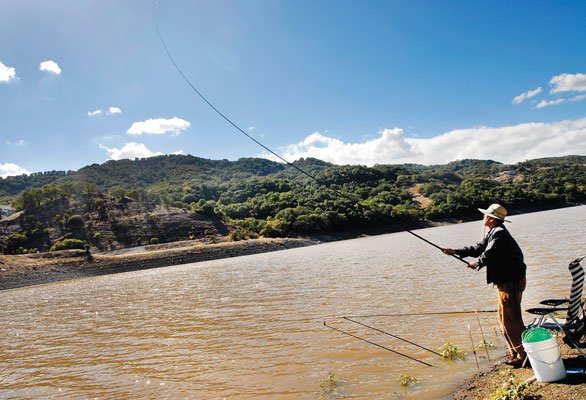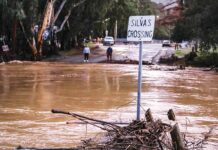Last week’s torrential rains proved healthy for local
reservoirs, potentially facilitating the balancing act that local,
state and federal agencies grapple with in ongoing efforts and
negotiations to protect threatened fish while maintaining adequate
drinking water and irrigation supply
– during a drought, no less.
Last week’s torrential rains proved healthy for local reservoirs, potentially facilitating the balancing act that local, state and federal agencies grapple with in ongoing efforts and negotiations to protect threatened fish while maintaining adequate drinking water and irrigation supply – during a drought, no less.
Water storage levels at four reservoirs in southern Santa Clara County rose to about 51 percent of their total capacity following the Oct. 13 storm that dumped nearly 7 inches of rain on Morgan Hill. The day before the storm Anderson, Coyote, Uvas and Chesbro reservoirs – which are owned by the Santa Clara Valley Water District – were about 46 percent full.
“Normally, the hills are so dry at this time of year that storms in October don’t generate runoff. But that storm saturated the watersheds and we did get some runoff,” explained Jeff Micko, a water district engineer and unit manager of the agency’s water supply operation.
That could ease the burden of meeting the district’s strategy to define its water release schedule from Uvas and Chesbro reservoirs in order to satisfy guidelines to protect the threatened Central Coast steelhead trout, while also fulfilling local needs of water supply and flood protection.
That strategy, which is largely dictated by state and federal agencies, includes tweaking the volume of water released by the season, depending on the steelhead’s spawning and migration patterns, according to Micko.
Currently, while the fish are mostly immobile, the district releases about five million gallons per day from Chesbro Reservoir, and about eight million gallons per day from Uvas Reservoir. Both reservoirs, in unincorporated west Morgan Hill, and their tributaries are designated as habitat and spawning ground for the steelhead, which was listed as a threatened species under the Federal Endangered Species Act in 1997.
That federal law “tends to trump” local water district decisions, Micko said.
“(Groundwater) is a public trust resource that has many beneficial uses, and those include water supply, habitat and recreation, among others,” Micko said. “A complicating factor is the ESA, which makes it illegal to take or ruin the habitat of threatened species.”
Balancing the needs of fish and the 1.8 million human residents served by the district can be a delicate task, requiring lengthy negotiations among responsible jurisdictions, including the state Department of Fish and Game, the National Marine Fisheries department, and the local water district. The effort is managed by the state Water Resources Quality Control Board.
Earlier this summer, district staff completed a study on the habitat, and are in the process of applying for a permit to allow some fish to die in the process of managing the two reservoirs, and replenishing local drinking water supplies. That permit is for the Santa Clara Valley Habitat Conservation Plan, a multi-agency long-term effort to balance development and endangered species’ needs.
At the beginning of each year, adult fish travel upstream from Monterey Bay, to the Pajaro River and up to Llagas and Uvas creeks, which are directly downstream from Chesbro and Uvas reservoirs, respectively. The adults lay eggs in those creeks in the late winter, then juvenile fish swim back out to Monterey Bay via the same route in the spring, Micko explained.
Thus, increasing volumes of water will be released over the next six months, in order to accommodate existing fish, well owners along the creeks, and to compensate for rainfall. By the spring, the district will release closer to the maximum allowable release – 17 million gallons per day out of Uvas Reservoir and eight million gallons per day out of Chesbro Reservoir.
Then, Micko said, as the rain stops falling and the fish become more inactive, water releases will drop again during the summer, until the rainy season of 2010 starts.
Uvas Reservoir, which releases into Uvas Creek, is a more important spawning ground for the steelhead as it remains connected to the Pajaro River year-round, and that’s why more water is released from it during the summer months, Micko said.
Chesbro Reservoir releases into Llagas Creek, which was dry before the creekbed reaches San Martin Avenue at the end of this summer. The district is allowed to let that part of the creek stay dry during the summer, because it is not as important as a habitat for the steelhead. A staff report presented to the district board of directors in July noted the steelhead only use about three miles of wet creek downstream from Chesbro.
A longtime resident of west Morgan Hill near Chesbro Reservoir said the release schedule over the last two years, when the current drought began, has baffled him. Chris Henry said during the 1980s, the district would follow a water release schedule similar to that described by Micko, “like clockwork.”
Then, last summer the district continued releasing water from Chesbro until it was almost completely dry, Henry explained, and the agency even put up public notices indicating the lake would be dry if the drought continued. He said this summer, the volume of water coming out of Chesbro was “more moderate,” but he wonders how the district will respond if the drought continues.
“There’s no point in releasing more water in the winter if it’s not raining,” Henry said. “The reservoir is not nearly as high as it was in 2006, but we had a tremendous amount of rain last Tuesday. But if it doesn’t rain, what is (the water district’s) plan?”
In future summers that follow wetter and more normal winters than the last two, the district could consider releasing more water into Llagas Creek, Micko said.
But the district also has to serve its local purpose of managing the local groundwater basin and providing flood protection. Micko said percolation into local wells that pull water out of the underground water supply is a key determinant of how far downstream Llagas Creek should be wet. Still, staff project that several hundred acre-feet of water per year is lost for groundwater uses to the district’s water release strategy, a supply the district will seek from other sources. The SCVHCP could incidentally allow the district to retain that supply from its traditional sources.
“Every year would be different, depending on how much rain we get,” Micko said. “We just have to manage it with (how much water) we have.”














